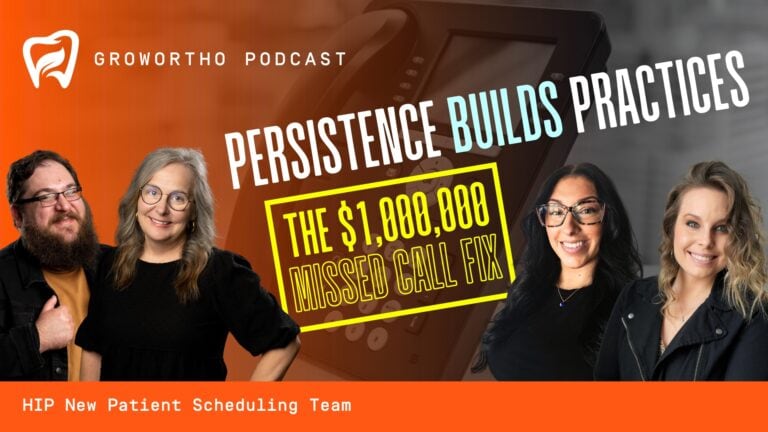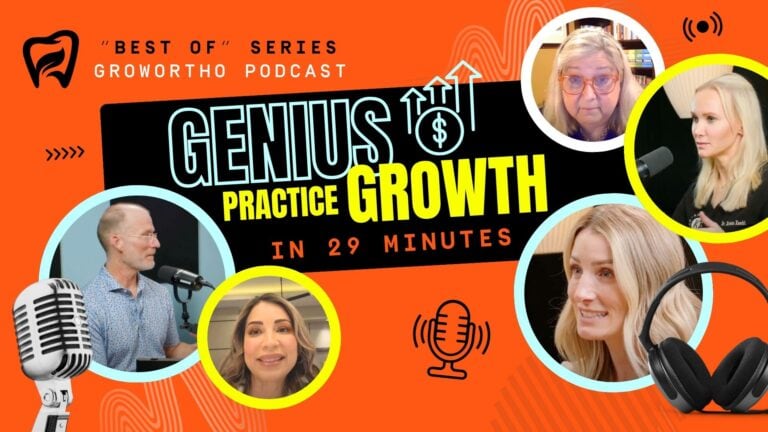Most orthodontic and dental practices sit on a goldmine they never touch. Every day, people call asking about treatment. They request information. Then life happens and they disappear.
They don’t mean to ghost you. They just get busy, lose confidence, or hit a financial snag.
But here’s the truth: buried in those old leads are your future patients. The difference between practices that grow and those that plateau? Persistence.
At HIP Creative, the New Patient Scheduling Team exists for one reason: make sure no potential patient falls through the cracks. They combine strategy, empathy, and relentless follow-through to transform “not yet” into “yes.” What happens on those calls goes far beyond scheduling. It’s about building trust, nurturing relationships, and understanding the real human stories behind each lead.
The Patient Who Said Yes After Two Years
Picture this: a lead sits in your system for two full years before finally scheduling.
For months, the New Patient Scheduling Team kept reaching out. The patient carried dental anxiety from previous bad experiences. She worried about the cost. But the follow-up never stopped.
Eventually, the timing clicked. The conversation wasn’t about pushing. It was about listening. That patient felt heard for the first time in years and decided to take the next step.
This story repeats itself constantly. Patients aren’t saying “no” forever. They’re saying “not right now.” The difference between losing them and helping them is how long you’re willing to stay in touch.
Why Follow-Up Gets Forgotten
Most front desk teams want to follow up. They know it matters. But in reality, they’re pulled in ten directions at once: checking in patients, verifying insurance, answering phones, managing schedules, and handling walk-in chaos.
Follow-up becomes the first casualty when the day gets hectic. Calls go unanswered. Texts go unsent.
As one team member put it, “The front desk is juggling so much. The phone rings, a patient walks in, another is checking out. Something has to give, and it’s usually the leads.”
That’s where the New Patient Scheduling Team steps in. By taking that responsibility off the in-office team, they free your staff to focus on what happens inside the practice while ensuring that every single lead still gets nurtured with care and consistency.
The System Behind Persistence
Persistence isn’t about luck or endless calling. It’s a process built on proven cadence, thoughtful timing, and authentic communication.
Here’s how the New Patient Scheduling Team does it:
Multiple Touch Points. They call leads at different times of day: morning, afternoon, and evening. This increases the chance of connection.
Text Before Calling. A quick, friendly text saying “Hey, this is Alyssa from [Practice Name]. I’ll be giving you a quick call shortly” builds trust and boosts answer rates.
Double Dialing. Calling twice back to back is surprisingly effective. It signals that the call matters.
Three-Day Cadence. Each lead is contacted multiple times over consecutive days, with strategic spacing to avoid feeling intrusive.
Long-Term Nurture. Even after months or years, the team continues reaching out with empathy and context. No lead is ever lost.
This cadence transforms follow-up from a task into a strategy. Every call, text, and note builds momentum. Every interaction brings a patient one step closer to starting treatment.
The Power of Empathy and Tone
Persistence only works when it’s paired with empathy. The New Patient Scheduling Team isn’t reading from a script. They’re listening for the “why” behind a patient’s hesitation.
Is it cost? Fear? A bad experience? Timing?
When someone says, “I can’t afford it,” the response isn’t a canned rebuttal. It’s a conversation about financing options, current offers, and the value of care. When a parent worries about their child’s anxiety, the tone shifts: calm, patient, reassuring.
Every team member is trained to adjust their tone, pace, and language based on the person they’re speaking to. A fast talker from New York gets quick, direct responses. A parent from the South gets warmth and conversation.
It’s not about selling. It’s about connecting. And connection builds confidence.
The Hidden Cost of Missed Calls
The numbers tell their own story.
Missing just one call per day can cost a practice nearly one million dollars in lost production over a year.
That’s not hypothetical. It’s math. Every call represents a patient who could have started treatment, referred friends, or brought in family.
When you multiply that by weeks, months, and years, it becomes clear: follow-up isn’t an afterthought. It’s one of the most powerful growth levers a practice can control.
No Lead Is Ever Lost
Inside PracticeBeacon, the team manages thousands of leads at once. Not one of them is considered dead.
They use a category called Long-Term Nurture, a list where leads who haven’t answered still receive regular, thoughtful outreach.
One specialist put it best: “A lead is never lost to us. Even if it’s been two years, we’ll still call, text, and check in. Life changes. Timing changes. Circumstances change.”
That long-term nurture process creates wins months or years down the road. Sometimes it’s the same patient finally ready. Sometimes it’s their child, sibling, or friend who schedules because of that consistent presence.
Persistence compounds over time.
Turning Conversations into Data
Another advantage of having a dedicated team? Insight. Every call becomes feedback that helps refine marketing and improve results.
The New Patient Scheduling Team works directly with HIP’s paid media department to share patterns they notice on calls: leads mentioning distance, cost concerns, or confusion about an offer.
If the leads are too far from the office, targeting radius gets adjusted. If cost objections increase, the offer gets re-evaluated. If engagement dips, messaging gets refined.
That real-time feedback loop saves partners money and improves conversion rates. It’s a full-circle approach where marketing and patient experience align.
Training That Never Stops
Persistence requires precision. Precision requires training.
The New Patient Scheduling Team doesn’t just rely on initial onboarding. Every week, calls are reviewed, tone is analyzed, and feedback is shared.
Team members practice slowing down, listening better, and adjusting to different patient personalities. They refine objection handling, empathy cues, and timing strategy.
As one specialist put it, “It’s easy to get comfortable when you make thousands of calls. That’s why we listen back, critique ourselves, and sharpen each other. There’s always something to improve.”
That continuous learning ensures that every call, the first or the five hundredth, feels personal, professional, and patient-centered.
Proof That Persistence Works
The results speak for themselves.
One partner who began working with the New Patient Scheduling Team saw production grow from one million dollars to 2.9 million dollars in just twelve months. The difference wasn’t a flood of new leads. It was better handling of the leads they already had.
That kind of growth doesn’t happen by accident. It happens when consistency meets compassion, when systems meet skill, and when practices refuse to let potential patients slip away.
Final Thoughts
Every lead represents a person, not just a number. And every person has their own timing, fears, and reasons.
The New Patient Scheduling Team succeeds because they understand that. They never assume a lack of response means a lack of interest. They stay patient, empathetic, and persistent.
In a world where attention spans are short and competition is fierce, the practices that win are the ones that care enough to keep showing up.
Because persistence doesn’t just book appointments. Persistence builds practices.
Ready to turn your missed calls into growth? Let’s talk about how the New Patient Scheduling Team can elevate your practice.




